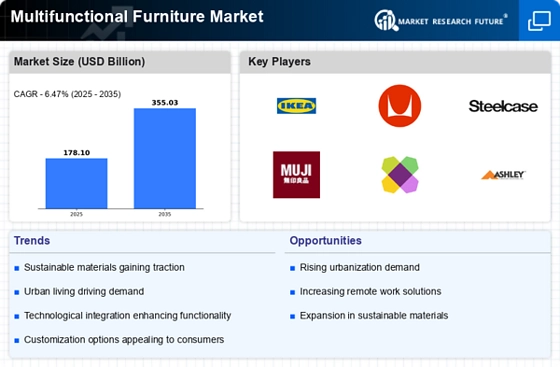The Multifunctional Furniture Market is currently characterized by a dynamic competitive landscape, driven by evolving consumer preferences for space-saving solutions and multifunctional designs. Key players such as IKEA (SE), Herman Miller (US), and Steelcase (US) are at the forefront, each adopting distinct strategies to enhance their market positioning. IKEA (SE) continues to leverage its strong brand identity and extensive product range, focusing on affordability and accessibility. In contrast, Herman Miller (US) emphasizes design innovation and sustainability, appealing to a more premium segment of the market. Steelcase (US) is strategically positioned towards the corporate sector, offering tailored solutions that enhance workplace productivity. Collectively, these strategies contribute to a moderately fragmented market, where innovation and customer-centric approaches are paramount.
In terms of business tactics, companies are increasingly localizing manufacturing to reduce lead times and enhance supply chain efficiency. This trend is particularly evident in the context of rising The Multifunctional Furniture Market demands. The competitive structure of the Multifunctional Furniture Market appears to be moderately fragmented, with several key players exerting influence through differentiated offerings and localized strategies. The collective actions of these companies shape a landscape where adaptability and responsiveness are critical for success.
In August 2025, IKEA (SE) announced the launch of a new line of modular furniture designed specifically for urban living spaces. This strategic move not only aligns with the growing trend of urbanization but also reinforces IKEA's commitment to providing practical solutions for space-constrained consumers. The modular design allows for customization, catering to diverse consumer needs and preferences, thereby enhancing customer engagement and loyalty.
In September 2025, Herman Miller (US) unveiled a partnership with a leading technology firm to integrate smart home features into its furniture offerings. This collaboration signifies a strategic pivot towards digitalization, enabling consumers to control their furniture through mobile applications. By embracing technology, Herman Miller (US) positions itself as a forward-thinking brand, appealing to tech-savvy consumers who prioritize convenience and innovation in their living spaces.
In October 2025, Steelcase (US) launched a new initiative aimed at promoting sustainable materials in its product lines. This initiative reflects a growing consumer demand for environmentally friendly options and positions Steelcase (US) as a leader in sustainability within the office furniture sector. By prioritizing eco-friendly materials, Steelcase (US) not only enhances its brand reputation but also aligns with global sustainability goals, potentially attracting a broader customer base.
As of October 2025, the Multifunctional Furniture Market is witnessing significant trends such as digitalization, sustainability, and the integration of artificial intelligence in product design. Strategic alliances among key players are increasingly shaping the competitive landscape, fostering innovation and enhancing product offerings. Looking ahead, it appears that competitive differentiation will evolve from traditional price-based competition to a focus on innovation, technology integration, and supply chain reliability. Companies that successfully navigate these trends are likely to secure a competitive edge in this rapidly changing market.


















Leave a Comment